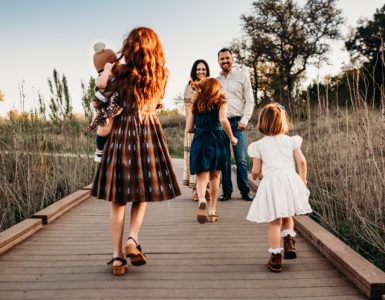When you hear the term “open adoption,” what do you visualize? Does it have a negative or positive connotation to you? And do you wonder how an open adoption could be beneficial for a child? I can share from professional and personal experience how an open adoption can be positive for everyone involved. This article will address what open adoption is, the differences between an open and closed adoption, how open adoption can be beneficial for the adoption triad, ways to build a positive relationship with a birth mother, personal stories from a birth mother and adoptive mother, and my personal experience with the open adoption of our daughter.
So, what is open adoption? It has become a popular topic when discussing adoption and relationships, but many do not understand what it really means. There are three types of adoptions: closed, semi-open, and open. The article “Types of Adoption” discusses them and the varying degrees of openness. A closed adoption provides for no contact between the adoption triad: the adoptive child, the adoptive parents, or the birth parents. The records could be sealed, and there is very limited to no information to share with the adoptive child about the birth family. Semi-open adoption offers some information that can be shared and is typically provided by the adoption agency. However, no personal information (phone numbers, addresses, etc.) is shared. Open adoption—on the other hand—offers contact and relationships within the triad. This means birth and adoptive parents can share personal information, send gifts, make phone calls, or even visit each other. This article, “The Differences Between Open Adoption and Closed Adoptions,” shares the importance of an open dialogue that is invaluable to the child as well as to everyone else involved. This dialogue and relationship may start before placement; the type of communication and the amount of communication will be determined by everyone’s comfort zone.
The primary concern is the best interests of the child. It is very important to note that the type of adoption or the degree of openness may change over time. For example, a family might start as a semi-open adoption and, after a period of time, evolve into a more open adoption because all the parties want more contact.
Many wonder how an open adoption can be beneficial for those in the triad. People often ask if it would confuse the adopted child. Shelley Skuster shared facts about open adoption in her article “6 Open Adoption Facts That Will Surprise You”. This article provides the many positive details which support how beneficial open adoption is for everyone involved. More people and more adoptions are leading to some form of open adoption. Skuster states that “95% of U.S. infant adoptions have some level of openness. 55% of adoptions are open or fully disclosed. 40% of adoptions are semi-open. 5% of adoptions are closed or confidential.” These rising percentages indicate a positive trend of open adoptions, and as people become more aware, the myths circulating about it will decrease. The article also states that most adult adoptees want to know their birth family or have questions they would like answered. Adoptees have also stated they enjoyed being part of an open adoption, and the adoptive parents of the adoptees said having a relationship with their children’s birth families was beneficial for their children. Open adoptions are also beneficial for the birth mothers and adoptive parents. It can help birth mothers cope with their grief and provide answers. It can also help adoptive parents become “more empathetic towards birth parents and children who are adopted.”
There are many different ways of communicating in an open adoption. While the biggest concern is meeting the needs of the child, communication should support the whole triad. If the triad decides on an open adoption, the next step is to determine the degree of openness. A discussion will need to take place on the amount and type of communication. There are many forms of communication, and one is social media. You can create private groups on Facebook or “friend” each other to share pictures and events. Other methods include text messaging or even emailing if you want a more secure way to communicate other than social media. Some triads may decide on scheduled visits. Of course, the physical location of families could be an issue, but virtual visits could always be arranged through Skype.
It is important to keep a balance of openness for all members of the triad. On Adoption.com, Amanda shares her personal journey as the birth mother in an open adoption triad. She answers many questions that people often wonder about from the birth mother’s point of view. She states that her expectations were met and often exceeded the degree of openness. The adoptive parents initially shared pictures/letters and later did visits a couple times a year. Amanda states she really enjoys these visits as she gets to see the whole family and build a relationship with everyone. When asked about the hardest aspect of open adoption, she mentioned boundaries. She states, “I know I could have been in person at every birthday or big event in Maddie’s life, but I respect Maddie’s adoptive parents and give them those moments. This doesn’t mean that I don’t love Maddie, but the opposite, that I love her and her family more.” She also states that she loves seeing pictures, seeing Maddie grow up, and seeing, physically, how much they look alike. Amanda also exemplifies the strength and love that comes from most birth mothers, saying “this was not about me, this was always about what’s best for Maddie,” and “I think as a birth mother, having an open adoption has helped me be proud of my decisions and has given me a confidence that has made me more powerful in my relationships with my husband and in my career.”
In “Why Are Birth Mothers So Important?”, another adoptive mother shares why the birth mother of her child is so vital, why they have an open adoption, and why the relationships within the triad are so important. She discusses the naivety she initially had about adoption and open adoption. She states that initially, her short answer of why birth mothers are so important is because adoptions would not and could not occur without them. Absolutely true! They make the ultimate sacrifice out of love, not for themselves, but for the child. This article shares details of her first meeting with her son’s birth mother, how it was awkward at first—as they had just met—and how looking back, they both laugh about their first meeting. I had the same naivety and unpreparedness when adopting our daughter. I had to learn how to be a mother, as well as how to process and adapt to our open adoption. And meeting a stranger is often awkward, but sometimes it’s a stranger who will now have a place in your life. Keep in mind the relationships are continuous and will evolve over time; relationships do not stay stagnant. This author also has a discussion on rules to follow regarding open adoption. There are no set rules, no manuals to follow, and no real right or wrong answers regarding open adoption.
The author of “Why Are Birth Mothers So Important?” has a toddler through a very open adoption, and the relationships have flourished. The author’s reason why birth mothers are so important is eloquently stated: “Her role was to give him the life she thought she couldn’t give him. Her role was to choose his forever parents. Her role was to birth him into this world. Her role was to place him with us. Her role was to feel confident in her decision. Her role was to fulfill something I will never be able to give to him: biology. Her role was to be there when we couldn’t. Her role wasn’t a one-stop shop, and we were done with her. Her role was to continue in his life.”
We also have a very open adoption with our daughter’s birth family. Unable to have children, my husband and I started the adoption process when we had been married about two years. We started the process for a domestic infant adoption, completed the process, and waited. Before too long, we were matched with an expectant mother which unfortunately ended in a failed adoption. We took a step back and went through a mourning period. We then asked our adoption agency to again show our lifebook to expectant mothers. A few days before Thanksgiving, I received a call from my pastor who had married us. She knew we had experienced a failed adoption and were again ready and wanting to adopt. She knew of a church member who had recently had a baby, but—due to her circumstances—was looking for a family to adopt the child. Through our agency, a meeting was arranged between the birth parents and us.
The meeting went extremely well, and the birth parents agreed that we would be the adoptive parents! However, that’s when things slowed down, and the uncertainty set in. Their daughter was just getting out of the NICU, and we spent many weeks waiting to hear back from the birth mother. The birth father had signed his relinquishment papers, but the birth mother was going through a time of uncertainty. This waiting period was very hard with all the unknown factors and uncertainty of whether this placement was going to happen. Finally, we heard back from our daughter’s birth mother, and a meeting was arranged for her to sign the relinquishment papers.
Prior to her signing the paperwork, we formulated a goodwill agreement establishing terms for the first year. This was to be a very open adoption. We determined how often we would Skype, send pictures, and do monthly visits. It was a demanding schedule and not always without frustration. However, we wanted to assure her she would be part of Anna’s life and that we were dedicated to the relationship. The first year was hard as she was still processing her grief and was unsure if we would be true to our commitment. Anna is now 6, and we still Skype and have visits; all is well.
Initially, I was scared, anxious, and nervous about open adoption. I was naive and had the same questions people typically ask and wonder: “Is it going to confuse our daughter as she gets older?” “What role will her birth mother play in our lives?” “What amount of openness would be appropriate for all of us?” “How will openness really work?”
But my anxiety was quickly lessened as we built our relationship. I learned how valuable her birth family can be to our daughter. Being a transracial family, I learned the importance of what they can provide culturally for our daughter. We learned our daughter can’t have too many people to love her.
Was it a learning process? Yes, as with any relationship. Is it a continuous and flexible relationship? Yes, as with any relationship. What are some methods and effective ways to build a good relationship with your child’s birth mother? The article “How Do I Have a Good Relationship With My Child’s Birth Mom?” provides ideas that may help in building a positive relationship. A prime takeaway from this article is to consider other positive relationships you have and determine what makes them work. Do they respect you and understand your boundaries? This relationship shouldn’t be any different. The writer also states it is very important to not forget the birth mother’s role. As she stated, “While your child’s birth mother is no longer your child’s parent, she will always be his mother. She won’t be a mother in the way that you and your partner may be mother or father. However, it is important that she knows that you understand she will always hold a special place in the heart and life of your child.”
Every open adoption will look different, some with minimal openness and some with deep involvement. Ours includes sending pictures through a private Shutterfly site weekly. We also Skype monthly with her birth mother and have quarterly visits.
We still have some family and friends who don’t understand open adoption. They don’t understand how seeing her birth mother wouldn’t confuse our daughter. They don’t understand that it is not “co-parenting,” and her birth mother cannot just take her from us.
As the birth mother story in the article, open adoption is not only for the birth mother to have a relationship with our daughter, but to benefit our daughter which also benefits our family. Her birth mother is supportive of the decisions we have made and does not interfere with them. She truly cares how we are doing with work and other activities. We adopted our son two years ago from China, and she was very excited for us. Now, whenever we have a visit and she brings our daughter a gift, she always brings a gift for our son as well. It is little things like that that show me the positive relationship we have together. Open adoption isn’t easy, and relationships require effort. Just as in any relationship, we must build trust, love, and commitment to the relationship for it to become sturdy. But, is open adoption worth it, if it is possible? Yes, I absolutely think so, for all involved, especially the child. Love is powerful.
Considering adoption? Let us help you on your journey to creating your forever family. Visit Adoption.org or call 1-800-ADOPT-98.




